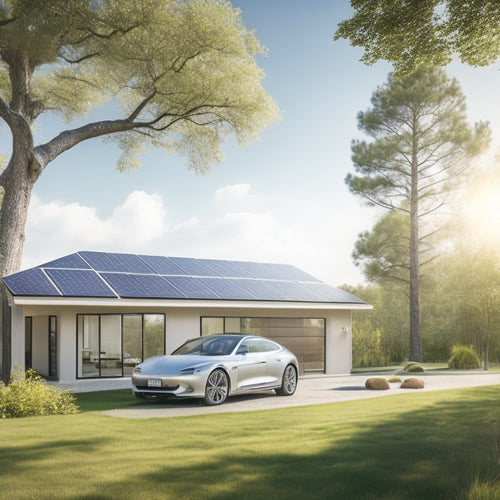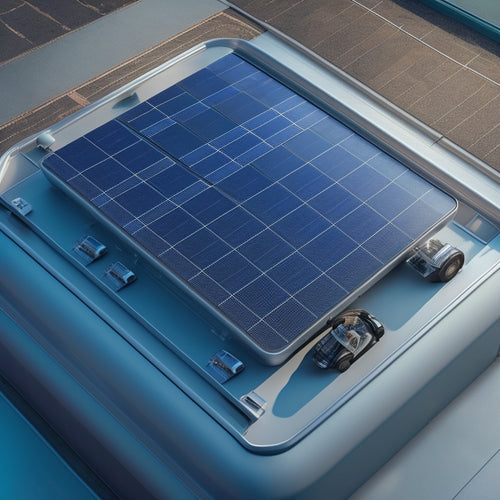
What Makes Modern Solar Panels More Efficient?
Share
You've upgraded to solar panels that employ energy more effectively, thanks to significant advancements in photovoltaic cell technology, panel design, and materials, which have collectively enhanced power output while minimizing environmental impact. Modern panels now feature perovskite cells, organic photovoltaics, and multi-junction technology, enabling them to make use of a wider range of light wavelengths and maximize output. Additionally, improved panel design and materials have reduced wind resistance, weight, and energy absorption, while enhanced energy conversion rates and surface area efficiency have increased power output. As you investigate the latest innovations, you'll uncover even more ways modern solar panels are revolutionizing clean energy.
Key Takeaways
- Advanced photovoltaic cell technologies like perovskite cells, organic photovoltaics, and multi-junction technology enhance energy conversion rates.
- Improved panel design and materials, including aerodynamic structures and high-quality glass, minimize energy loss and maximize output.
- High-efficiency solar cells, multi-junction solar cells, and anti-reflective coatings optimize light wavelength utilization for better energy yields.
- Increased surface area efficiency through thin film layers, bifacial panel designs, and nanostructured surfaces amplifies photon-to-electron conversion.
- Better temperature coefficient ratings and thermal management technologies ensure consistent performance and minimize efficiency losses in high temperatures.
Advanced Photovoltaic Cell Technology
The development of advanced photovoltaic cell technology has been essential in enhancing the efficiency of modern solar panels.
You've likely heard of perovskite cells, which have recently gained attention for their high power conversion efficiency.
But that's not all - organic photovoltaics have also shown promising results, offering a potentially more cost-effective and flexible alternative.
Multi-junction technology has also been a breakthrough, allowing for the utilizing of a wider range of light.
In addition, innovations in solar cell recycling have reduced waste and minimized environmental impact.
Quantum dot applications have also been investigated, enabling the creation of more efficient and durable cells.
Transparent electrodes have improved light management, allowing more photons to be absorbed.
Additionally, the integration of energy storage systems has enabled more efficient energy harvesting and reduced grid dependence.
As you examine the world of modern solar panels, it's clear that advancements in photovoltaic cell technology have played an essential role in driving efficiency forward.
Improved Panel Design and Materials
As you investigate the world of modern solar panels, you'll find that improved panel design and materials have greatly contributed to enhanced efficiency.
The innovative design of modern solar panels features aerodynamic structures that reduce wind resistance, allowing for better energy harvesting. This is achieved through cleverly engineered frames that minimize air friction, resulting in increased energy output.
In addition, the incorporation of lightweight materials has drastically reduced the overall weight of the panels. This not only makes them easier to transport and install but also enables more efficient energy conversion.
Moreover, modern solar panels now employ advanced materials with improved thermal conductivity. This allows for more efficient heat dissipation, reducing the risk of overheating and subsequent energy losses.
The use of high-quality, low-iron glass also minimizes energy absorption, ensuring that more sunlight is converted into electricity.
Enhanced Energy Conversion Rates
You'll notice that modern solar panels boast enhanced energy conversion rates, thanks to significant advancements in photovoltaic cell technology. This improvement is largely due to the development of high-efficiency solar cells that can utilize a wider range of light wavelengths. By optimizing the photovoltaic cells to capture more photons, modern solar panels can convert sunlight into electricity with greater precision. As a result, you'll experience higher energy yields and a reduced environmental impact.
The increased energy conversion rates also enable solar panels to perform better in low-light conditions, making them more versatile and reliable.
The enhanced energy conversion rates are achieved through advanced manufacturing techniques and innovative materials. For instance, some modern solar panels employ multi-junction solar cells that can capture energy from different light wavelengths. This allows them to maximize energy output while minimizing energy losses.
Additionally, the use of high-purity silicon and advanced anti-reflective coatings further enhances energy conversion rates. With these advancements, modern solar panels can generate more power per unit area, making them a more attractive option for those seeking to reduce their carbon footprint.
Increased Surface Area Efficiency
You're now exploring the domain of increased surface area efficiency, where innovative designs and materials come into play.
Thin film layers, for instance, enable a more extensive absorption of sunlight, while bifacial panel designs can capture radiation from both the front and back sides.
Meanwhile, nanostructured surfaces are being developed to maximize photon-to-electron conversion, further enhancing overall efficiency.
Thin Film Layers
Thin film layers are revolutionizing modern solar panels by greatly increasing their surface area efficiency. When you integrate these thin films into your solar panel design, you can expect a significant enhancement in energy output. This is because thin film layers have a higher surface area-to-volume ratio, allowing them to capture more sunlight and convert it into electricity.
Manufacturing techniques have played an essential role in the development of thin film layers. Advances in deposition methods, such as chemical vapor deposition and sputtering, have enabled the production of high-quality thin films with precise control over their thickness and composition.
Additionally, material advancements have led to the identification of new thin film materials with improved optical and electrical properties. These breakthroughs have enabled the creation of ultra-thin films that can be easily integrated into solar panels, increasing their energy-harvesting capabilities without adding bulk or weight.
As a result, you can now utilize more power from the sun with thinner, lighter, and more efficient solar panels.
Bifacial Panel Design
With the rise of thin film layers, another design innovation is taking center stage: bifacial panel design. This technology allows you to utilize energy from both the front and back sides of the solar panel, increasing overall energy output.
By leveraging bifacial advantages, you can enhance your system's performance by up to 25%. This is achieved by using a transparent or semi-transparent backsheet, which enables the panel to absorb light reflected from the ground or surrounding environment.
When it comes to installation techniques, bifacial panels require careful planning to maximize energy gain. You'll need to evaluate factors such as panel tilt, orientation, and surface reflectivity to guarantee optimal energy harvesting.
For instance, installing bifacial panels on a white or light-colored rooftop can increase energy output by reflecting more light onto the backside of the panel.
Nanostructured Surfaces
Nanostructured surfaces, similar to a microscopic forest, amplify the surface area of solar panels, enabling them to capture more energy from the sun. This innovative design allows you to utilize more power from the same amount of sunlight.
By increasing the surface area, nanostructured surfaces enhance light absorption and reduce reflection, resulting in higher energy yields.
Some key features of nanostructured surfaces include:
-
Increased surface area: Nanostructures provide a larger surface area for photons to interact with, increasing the chances of absorption and energy conversion.
-
Improved light trapping: The unique structure of nano-surfaces enables more efficient light trapping, reducing the amount of light that's lost due to reflection.
-
Thinner surface coatings: Nanostructured surfaces can be achieved with thinner surface coatings, reducing material costs and environmental impact.
-
Enhanced durability: Nano-surfaces can be designed to be more resistant to environmental degradation, ensuring consistent performance over time.
-
Customizable nano-architectures: Researchers can tailor nano-structures to optimize energy conversion for specific applications, from rooftop installations to large-scale solar farms.
Better Temperature Coefficient Ratings
Better Temperature Coefficient Ratings
You're likely aware that high temperatures can negatively impact solar panel efficiency. That's why modern solar panels boast better temperature coefficient ratings, ensuring peak performance even in scorching conditions. A temperature coefficient rating measures how well a solar panel withstands heat-induced efficiency losses. A lower rating indicates better temperature stability and thermal management.
| Temperature Range (°C) | Efficiency Loss (%) | Temperature Coefficient Rating |
|---|---|---|
| 25-40 | 1.5-2.5 | -0.45% per °C |
| 40-60 | 3.5-5.5 | -0.35% per °C |
| 60-80 | 6.5-8.5 | -0.25% per °C |
As the table illustrates, modern solar panels exhibit improved temperature coefficient ratings, resulting in minimal efficiency losses even at increased temperatures. This means you can expect consistent power output from your solar panels, regardless of the outside temperature. By minimizing thermal losses, modern solar panels maximize energy production, giving you the power you need to meet your energy demands.
Smart Panel Monitoring Systems
Your solar panel system is a sophisticated network of components, and modern panels take it to the next level with smart panel monitoring systems.
These advanced systems allow you to track your solar panel's performance in real-time, identifying any issues before they become major problems. With real-time analytics, you can enhance your energy production and reduce downtime.
Here's what you can expect from smart panel monitoring systems:
-
Real-time monitoring: Track your energy production in real-time, receiving instant notifications of any performance issues.
-
Predictive maintenance: Identify potential problems before they occur, scheduling maintenance during ideal times to minimize downtime.
-
Energy forecasting: Accurately predict your energy production, allowing you to plan your energy usage and maximize your savings.
-
Remote troubleshooting: Diagnose and resolve issues remotely, reducing the need for on-site visits and minimizing repair costs.
-
Data analytics: Gain significant understanding into your energy production, helping you enhance your system for maximum efficiency.
Frequently Asked Questions
Can Solar Panels Generate Power During Rainy or Cloudy Days?
You'll be glad to know that, yes, solar panels can generate power during rainy or cloudy days, albeit with reduced solar efficiency, as weather impact limits energy output; however, modern panels are designed to optimize energy harvesting in various weather conditions.
How Long Do Modern Solar Panels Typically Last?
You're wondering how long modern solar panels last? Typically, they'll serve you for 25-30 years or more, depending on durability factors that impact their lifetime expectancy, such as quality, maintenance, and environmental conditions.
Can I Install Solar Panels on My Old or Historic Home?
As you commence on utilizing solar power, you'll find that installing panels on your old or historic home requires a delicate balance between energy efficiency and historic preservation, necessitating careful direction of installation permits to guarantee a seamless fusion of old and new.
Do Solar Panels Require Regular Cleaning and Maintenance?
You'll need to clean your solar panels regularly to maintain their efficiency; aim for a cleaning frequency of every 6-12 months, and follow maintenance tips like using a soft-bristled brush and deionized water to remove debris and dirt.
Are Solar Panels Recyclable at the End of Their Life Cycle?
You'll be relieved to know that, yes, solar panels are recyclable, and you'll play an essential role in responsible solar panel disposal by participating in recycling processes that recover precious materials like silicon, aluminum, and glass.
Related Posts
-

Why Invest in Solar Car Battery Chargers Online?
By investing in a solar car battery charger online, you're not only reducing your reliance on fossil fuels but also o...
-

Top Solar Panels for Car Battery Maintenance
When selecting top solar panels for car battery maintenance, consider high-efficiency models with high wattage output...
-

Top 10 DIY Conversion Kit Reviews and Tips
You're taking the first step towards electrifying your ride, and with the right DIY conversion kit, you'll be cruisin...


